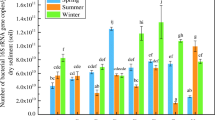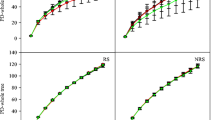Abstract
Vertical flow constructed wetlands (VF CWs) are considered to be effective for treating organic pollutants. The rhizosphere of macrophytes such as Phragmites sp., Typha sp. serves as an active and dynamic zone for the microbial degradation of organic pollutants. However, it is still not clear how soil bacterial communities respond to macrophytes and pollutants during the process. For this purpose, the seedlings of Phragmites australis and Typha angustifolia were planted respectively in the VF CWs added with HCB at a dose of 2 mg/kg. During 96 days of cultivation, we monitored hexachlorobenzene (HCB) removal efficiency by GC/MS and the structure of the rhizosphere bacterial communities in the different VF CWs by denaturing gradient gel electrophoresis (DGGE), and constructed bacterial clone library based on PCR-amplified 16S rRNA gene. As expected, the rhizosphere bacterial communities also remained insensitive to HCB exposure in the wetland soil. The diversity of these microbes presented two stages, from the varied up and down to equilibrium in the entire experimental period. Molecular analysis revealed that the phylum Firmicutes dominated over the bacterial communities. The genera that increased under HCB stress included the well-known HCB-degrading bacteria (Pseudomonas sp. and Alcaligenes sp.) and other common bacteria found in contaminated soil but with lesser known practical functions (Burkholderia sp., Lysinibacillus fusiformis, and Bacillus cereus). Furthermore, there was a certain variance in the relative abundances of the bacterial phyla and HCB removal efficiency among different VF CW treatments. The degradation of HCB in T. angustifolia microcosms was faster than that in P. australis and unvegetated wetlands, and the highest bacterial diversity and richness was found in the VF CWs comprising T. angustifolia.





Similar content being viewed by others
References
Arroyo P, Ansola G, Miera LES (2013) Effects of substrate, vegetation and flow on arsenic and zinc removal efficiency and microbial diversity in constructed wetlands. Ecol Eng 51:95–103
Ávila C, Bayona JM, Martín I, Salas JJ, García J (2015) Emerging organic contaminant removal in a full-scale hybrid constructed wetland system for wastewater treatment and reuse. Ecol Eng 80:108–116
Barbera JL, Sweetman AJ, Wijk D, Jones KC (2005) Hexachlorobenzene in the global environment: emissions, levels, distribution, trends and processes. Sci Total Environ 349:1–44
Berg G, Smalla K (2009) Plant species and soil type cooperatively shape the structure and function of microbial communities in the rhizosphere. FEMS 68:1–13
Bernard L, Mougel C, Maron PA, Nowak V, Leveque J, Henault C, Haichar FZ, Berge O, Marol C, Balesdent J, Gibiat F, Lemanceau P, Ranjard L (2007) Dynamics and identification of soil microbial populations actively assimilating carbon from C-13-labelled wheat residue as estimated by DNA- and RNA-SIP techniques. Environ Microbiol 9:752–764
Bertin C, Yang XH, Weston LA (2003) The role of root exudates and allelochemicals in the rhizosphere. Plant Soil 256:67–83
Bulgarelli D, Schlaeppi K, Spaepen S, Themaat EVL, Schulze-Lefert P (2013) Structure and functions of the bacterial microbiota of plants. Annu Rev Plant Biol 64:807–838
Chalouati H, Boutet E, Metais B, Fouche E, Sâada MMB, Gamet-Payrastre L (2015) DNA damage and oxidative stress induced at low doses by the fungicide hexachlorobenzene in human intestinal Caco-2 cells. Toxicol Mech Method 6(25):448–458
Crouzet O, Poly F, Bonnemoy F, Bru D, Batisson I, Bohatier J, Philippot L, Mallet C (2015) Functional and structural responses of soil N-cycling microbial communities to the herbicide mesotrione: a dose-effect microcosm approach. Environ Sci Pollut Res 6:1–11
Dankwardt A, Hock B (2001) Immunolocalization of nonextractable (bound) residues of pesticides and industrial contaminants in plants and soil. Chemosphere 45:523–533
Fierer N, Bradford MA, Jackson RB (2007) Toward an ecological classification of soil bacteria. Ecology 88:1354–1364
Goldfarb KC, Karaoz U, Hanson CA, Santee CA, Bradford MA, Treseder KK, Wallenstein MD, Brodie EL (2011) Differential growth responses of soil bacterial taxa to carbon substrates of varying chemical recalcitrance. Front Microbiol 2:94–100
Goswami MR, Pati UK, Chowdhury A, Mukhopadhyay A (2013) Studies on the effect of cypermethrin on soil microbial biomass and its activity in an alluvial soil. Inter J Agric Food Sci 3:1–9
Gundi VAKB, Narasimha G, Reddy BR (2005) Interaction effects of insecticides on microbial populations and dehydrogenase activity in a black clay soil. J Environ Sci Health B 40:269–283
Kelly JJ, Häggblom M, Tate RL (2003) Effects of heavy metal contamination and remediation on soil microbial communities in the vicinity of a zinc smelter as indicated by analysis of microbial community phospholipid fatty acid profiles. Biol Fert Soils 38:65–71
Li XZ, Rui JP, Mao YJ, Yannarell A, Mackie R (2014) Dynamics of the bacterial community structure in the rhizosphere of a maize cultivar. Soil Biol Biochem 68:392–401
Liu T, Chen ZL, Shen YF (2009) Aerobic biodegradation of hexachlorobenzene by an acclimated microbial community. Int J Environ Pollut 37:235–244
Lovecka P, Pacovska I, Stursa P, Vrchotova B, Kochankova L, Demnerova K (2015) Organochlorinated pesticide degrading microorganisms isolated from contaminated soil. New Biotechnol 32:26–31
Ma X, Havelka MM (2009) Phytotoxicity of chlorinated benzenes to Typha angustifolia and Phragmites communis. Environ Toxicol 24:43–48
Merlin C, Devers M, Béguet J, Boggio B, Rouard N, Martin-Laurent F (2015) Evaluation of the ecotoxicological impact of the organochlorine chlordecone on soil microbial community structure, abundance, and function. Environ Sci Pollut Res 3:1–14
Naidu MP, Prasanna T (2013) MICs of cypermethrin, chlorpyriphos and monochrotophos pesticides sprayed in agricultural fields of Coccinia grandis on soil microbes. Curr Res Microbiol Biotechnol 1:12–15
Òvreas L, Forney L, Daae FL, Torsvik V (1997) Distribution of bacterioplankton in meromictic lake Saelevannet, as determined by denaturing gradient gel electrophoresis of PCR-amplified gene fragments coding for 16S rRNA. Appl Environ Microbiol 63:3367–3373
Philippot L, Raaijmakers JM, Lemanceau P, Putten WH (2013) Going back to the roots: the microbial ecology of the rhizosphere. Nat Rev Microbiol 1–11
Piotrowska-Seget Z, Cycon M, Kozdroj J (2005) Metaltolerant bacteria occurring in heavily polluted soil and mine spoil. Appl Soil Ecol 28:237–246
Ravenschlag K, Sahm K, Pernthaler J, Amann R (1999) High bacterial diversity in permanently cold marine sediments. Appl Environ Microbiol 65(9):3982–3989
Schloss PD, Handelsman JA (2005) Computer program for defining operational taxonomic units and estimating species richness. Appl Environ Microbiol 71:1501–1506
Stottmeister U, Wießner A, Kuschk P, Kappelmeyer U, Kästner M, Bederski O, Müller RA, Moormann H (2003) Effects of plants and microorganisms in constructed wetlands for wastewater treatment. Biotechnol Adv 22:93–117
Sunil S, Rashi G, Shilpi S (2015) Effects of chemical and biological pesticides on plant growth parameters and rhizospheric bacterial community structure in Vigna radiata. J Hazard Mater 291:102–110
Takagi K, Iwasaki A, Kamei I, Satsuma K, Yoshioka Y, Harada N (2009) Aerobic mineralization of hexachlorobenzene by newly isolated pentachloronitrobenzene-degrading Nocardioides sp. strain PD653. Appl Environ Microbiol 75:4452–4458
Tejada M, García C, Hernández T, Gómez I (2015) Response of soil microbial activity and biodiversity in soils polluted with different concentrations of cypermethrin insecticide. Arch Environ Contam Toxicol 12:1–12
Uhlik O, Strejcek M, Vondracek J, Musilova L, Ridl J, Lovecka P, Maceka T (2014) Bacterial acquisition of hexachlorobenzene-derived carbon in contaminated soil. Chemosphere 113:141–145
Van Eerd LL, Hoagland RE, Zablotowicz RM, Hall JC (2003) Pesticide metabolism in plants and microorganisms. Weed Sci 51:472–495
Viñas M, Sabaté J, Espuny MJ, Solanas AM (2005) Bacterial community dynamics and polycyclic aromatic hydrocarbon degradation during bioremediation of heavily creosote- contaminated soil. Appl Environ Microbiol 11(71):7008–7018
Vodovnik M, Bistan M, Zorec M, Logar RM (2012) Membrane changes associated with exposure of pseudomonas putida to selected environmental pollutants and their possible roles in toxicity. Acta Chim Slov 59:83–88
Vymazal J (2011) Constructed wetlands for wastewater treatment: five decades of experience. Environ Sci Technol 45:61–69
Vymazal J, Březinová T (2016) Accumulation of heavy metals in aboveground biomass of Phragmites australis in horizontal flow constructed wetlands for wastewater treatment: a review. Chem Eng J 290:232–242
Wang G, Lu YL, Han JY, Luo W, Shi YJ, Wang TY, Sun YM (2010) Hexachlorobenzene sources, levels and human exposure in the environment of China. Environ Int 36:122–130
Wang B, Zhang CP, Li SY, Lu GQ, Lu GL, Li S, Zhou YQ (2016) An approach to biodegradation of chlorobenzenes: combination of and bacterial effects on hexachlorobenzene degradation in water. doi: 10.2166/wst.2016.313
Yang CH, Crowley DE (2000) Rhizosphere microbial community structure in relation to root location and plant iron nutritional status. Appl Environ Microbiol 66:345–351
Zhou YQ, Li XZ, Li SY, Tang YY, Xin ZJ, Jia Y (2011) A review on soil microbial community in different type constructed wetlands. Chinese J Ecol 30(6):1251–1257
Zhou YQ, Trestip S, Li XZ, Truu M, Truu J, Mander Ü (2012) Dechlorination of hexachlorobenzene in treatment microcosm wetlands. Ecol Eng 42:249–255
Zhou YQ, Tigane T, Li XZ, Truu M, Truu J, Mander Ü (2013) Hexachlorobenzene dechlorination in constructed wetland mesocosms. Water Res 47:102–110
Acknowledgements
This study was supported by the National Natural Science Foundation of China (grant no. 31460144, 41471149, 41501508 & 31670472) and the Key Projects in Yunnan Province Department of Education (grant no. 2014Z148). The constructive comments and suggestions on an earlier draft of this paper by the editor and anonymous reviewers are also appreciated.
Author information
Authors and Affiliations
Corresponding author
Additional information
Responsible editor: Robert Duran
Cuiping Zhang and Bei Wang contributed equally to this work
Electronic supplementary material
Supplementary Table 1a
(DOC 202 kb).
Rights and permissions
About this article
Cite this article
Zhang, C., Wang, B., Dai, X. et al. Structure and function of the bacterial communities during rhizoremediation of hexachlorobenzene in constructed wetlands. Environ Sci Pollut Res 24, 11483–11492 (2017). https://doi.org/10.1007/s11356-017-8463-1
Received:
Accepted:
Published:
Issue Date:
DOI: https://doi.org/10.1007/s11356-017-8463-1




